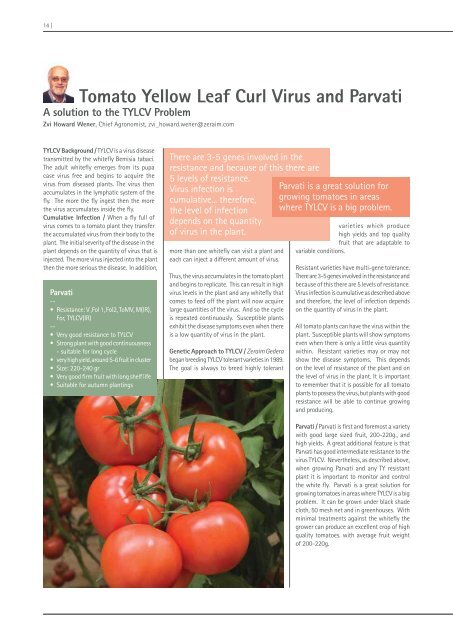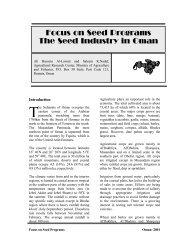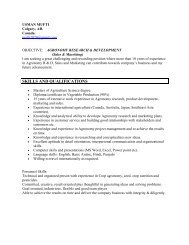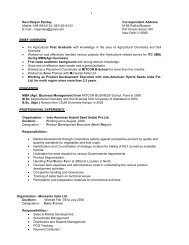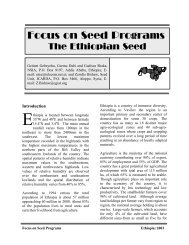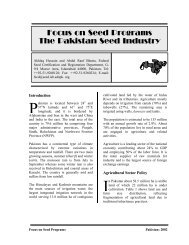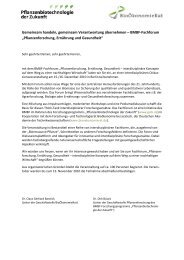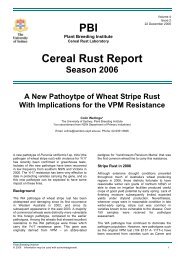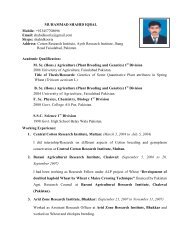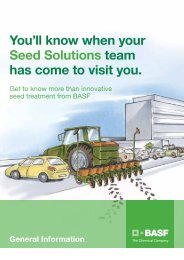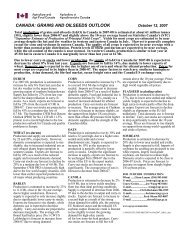Download newsletter - SeedQuest
Download newsletter - SeedQuest
Download newsletter - SeedQuest
You also want an ePaper? Increase the reach of your titles
YUMPU automatically turns print PDFs into web optimized ePapers that Google loves.
14 |<br />
Tomato Yellow Leaf Curl Virus and Parvati<br />
A solution to the TYLCV Problem<br />
Zvi Howard Wener, Chief Agronomist, zvi_howard.wener@zeraim.com<br />
TYLCV Background / TYLCV is a virus disease<br />
transmitted by the whitefly Bemisia tabaci.<br />
The adult whitefly emerges from its pupa<br />
case virus free and begins to acquire the<br />
virus from diseased plants. The virus then<br />
accumulates in the lymphatic system of the<br />
fly. The more the fly ingest then the more<br />
the virus accumulates inside the fly.<br />
Cumulative Infection / When a fly full of<br />
virus comes to a tomato plant they transfer<br />
the accumulated virus from their body to the<br />
plant. The initial severity of the disease in the<br />
plant depends on the quantity of virus that is<br />
injected. The more virus injected into the plant<br />
then the more serious the disease. In addition,<br />
Parvati<br />
--<br />
• Resistance: V ,Fol 1, Fol2, ToMV, M(IR),<br />
For, TYLCV(IR)<br />
--<br />
• Very good resistance to TYLCV<br />
• Strong plant with good continuousness<br />
- suitable for long cycle<br />
• very high yield, around 5-6 fruit in cluster<br />
• Size: 220-240 gr<br />
• Very good firm fruit with long shelf life<br />
• Suitable for autumn plantings<br />
There are 3-5 genes involved in the<br />
resistance and because of this there are<br />
5 levels of resistance.<br />
Virus infection is<br />
cumulative... therefore,<br />
the level of infection<br />
depends on the quantity<br />
of virus in the plant.<br />
more than one whitefly can visit a plant and<br />
each can inject a different amount of virus.<br />
Thus, the virus accumulates in the tomato plant<br />
and begins to replicate. This can result in high<br />
virus levels in the plant and any whitefly that<br />
comes to feed off the plant will now acquire<br />
large quantities of the virus. And so the cycle<br />
is repeated continuously. Susceptible plants<br />
exhibit the disease symptoms even when there<br />
is a low quantity of virus in the plant.<br />
Genetic Approach to TYLCV / Zeraim Gedera<br />
began breeding TYLCV tolerant varieties in 1989.<br />
The goal is always to breed highly tolerant<br />
Parvati is a great solution for<br />
growing tomatoes in areas<br />
where TYLCV is a big problem.<br />
varieties which produce<br />
high yields and top quality<br />
fruit that are adaptable to<br />
variable conditions.<br />
Resistant varieties have multi-gene tolerance.<br />
There are 3-5 genes involved in the resistance and<br />
because of this there are 5 levels of resistance.<br />
Virus infection is cumulative as described above<br />
and therefore, the level of infection depends<br />
on the quantity of virus in the plant.<br />
All tomato plants can have the virus within the<br />
plant. Susceptible plants will show symptoms<br />
even when there is only a little virus quantity<br />
within. Resistant varieties may or may not<br />
show the disease symptoms. This depends<br />
on the level of resistance of the plant and on<br />
the level of virus in the plant. It is important<br />
to remember that it is possible for all tomato<br />
plants to possess the virus, but plants with good<br />
resistance will be able to continue growing<br />
and producing.<br />
Parvati / Parvati is first and foremost a variety<br />
with good large sized fruit, 200-220g., and<br />
high yields. A great additional feature is that<br />
Parvati has good intermediate resistance to the<br />
virus TYLCV. Nevertheless, as described above,<br />
when growing Parvati and any TY resistant<br />
plant it is important to monitor and control<br />
the white fly. Parvati is a great solution for<br />
growing tomatoes in areas where TYLCV is a big<br />
problem. It can be grown under black shade<br />
cloth, 50 mesh net and in greenhouses. With<br />
minimal treatments against the whitefly the<br />
grower can produce an excellent crop of high<br />
quality tomatoes. with average fruit weight<br />
of 200-220g.


